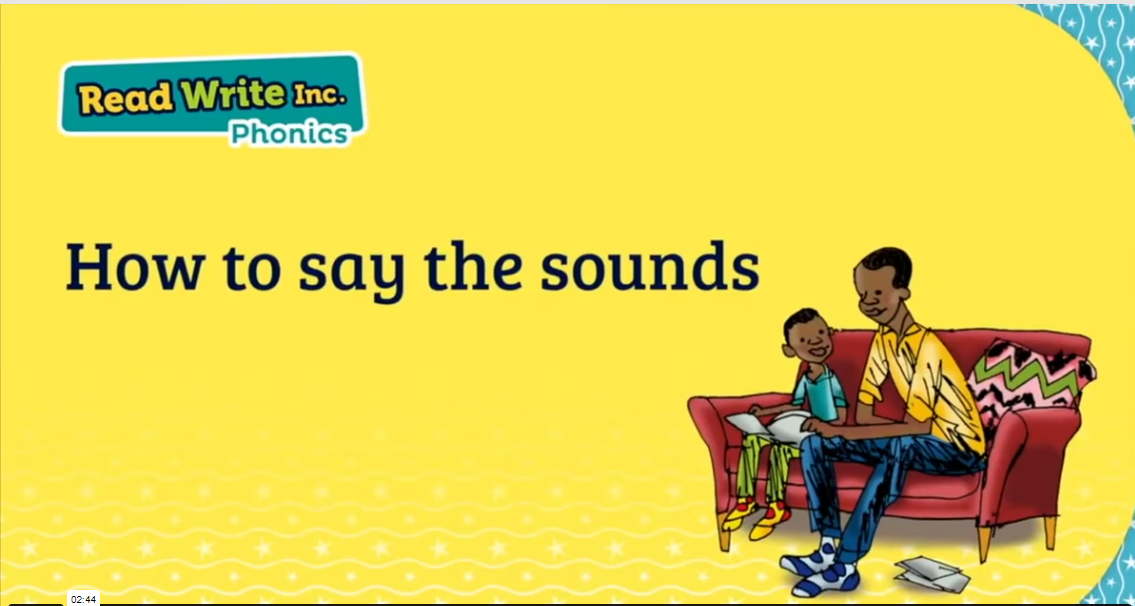Reception
There is a lot of information on this page, including the downloadable welcome information pack:
This covers everything shared at the welcome meeting. If you would like the pack translated, let us know.
You are not expected to know everything and starting school as a new parent or carer can feel overwhelming. Just ask if you are unsure of anything!
Our vision and values
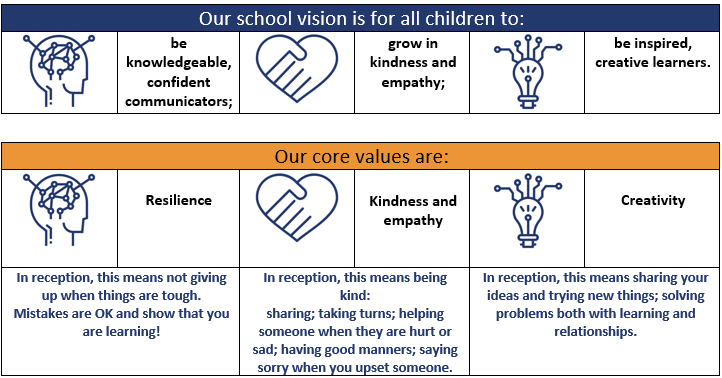
Our curriculum intent
Our curriculum is implemented on a topic-based approach which has been planned to meet the needs of all children. This approach allows children to identify connections between the different areas of learning and use these skills across different contexts, to scaffold and strengthen understanding.
The learning environments, inside and out, promote all 7 areas of learning and development and meet the varied needs of early learners. Environments are purposefully responsive and fluid. Children’s new interests and fascinations will be incorporated at speed so that children see the value of their ideas and interests. It is paramount at St Margaret’s that children see themselves as able to shape and contribute to their education from the start.
The environment is language-rich and helps children to learn new vocabulary and extend their linguistic skills. Reading is at the heart of our EYFS curriculum, with high quality core texts at the centre of each half-term's planning and a rigorous phonics scheme to support the children’s early reading experience in the form of Read, Write Inc.
A mastery approach to maths is embedded in reception to allow a smooth transition to KS1, following White Rose materials.
Early identification of SEND allows rapid interventions to be planned so that all children are able to make excellent progress from their starting points.
Throughout the year we celebrate a wide variety of culturally significant days that reflect our community and the wider world as well as religious festivals.
Our curriculum topics

Our curriculum overview
Central to our EYFS curriculum are the characteristics of effective learning:

Our curriculum is organised into areas of learning and development.
The prime areas of development are like the foundations or building blocks for learning. During the first half term in reception, these are a priority. When children are secure in these areas, learning in the specific subject areas is more impactful.
The Prime Areas are:
- Communication and Language
- Personal, Social and Emotional Development
- Physical Development
The following charts outline the key ‘headlines’ for teaching and learning in each area of learning and development, as well as the ‘Early Learning Goals’ (what we want children to achieve by the end of Reception year).

By the end of the Reception year, children at the expected level of development will:
- listen attentively and respond to what they hear with relevant questions, comments and actions when being read to and during whole class discussions and small group interactions
- make comments about what they have heard and ask questions to clarify their understanding
- hold conversation when engaged in back-and-forth exchanges with their teacher and peers.

By the end of the Reception year, children at the expected level of development will:
- participate in small group, class and one-to-one discussions, offering their own ideas, using recently introduced vocabulary
- offer explanations for why things might happen, making use of recently introduced vocabulary from stories, non-fiction, rhymes and poems when appropriate
- express their ideas and feelings about their experiences using full sentences, including use of past, present and future tenses and making use of conjunctions, with modelling and support from their teacher.

By the end of the Reception year, children at the expected level of development will:
Self-Regulation
- show an understanding of their own feelings and those of others, and begin to regulate their behaviour accordingly
- set and work towards simple goals, being able to wait for what they want and control their immediate impulses when appropriate
- give focused attention to what the teacher says, responding appropriately even when engaged in activity, and show an ability to follow instructions involving several ideas or actions.
Managing Self
- be confident to try new activities and show independence, resilience and perseverance in the face of challenge
- explain the reasons for rules, know right from wrong and try to behave accordingly
- manage their own basic hygiene and personal needs, including dressing, going to the toilet and understanding the importance of healthy food choices.
Building Relationships
- work and play cooperatively and take turns with others
- form positive attachments to adults and friendships with peers
- show sensitivity to their own and to others’ needs.

By the end of the Reception year, children at the expected level of development will:
- negotiate space and obstacles safely, with consideration for themselves and others
- demonstrate strength, balance and coordination when playing
- move energetically, such as running, jumping, dancing, hopping, skipping and climbing.

By the end of the Reception year, children at the expected level of development will:
- hold a pencil effectively in preparation for fluent writing – using the tripod grip in almost all cases
- use a range of small tools, including scissors, paint brushes and cutlery
- begin to show accuracy and care when drawing.
What should my child be able to do before starting Reception?
All children develop at different rates and at different stages. However, things Reception children need to be doing at the start of the school year (so please practice repeatedly through the holidays) include:
- Toilet Training
- Toilet trained, including effective wiping and how to flush a toilet. Followed by washing hands with soap and water every time.
- Training boys on holding and pointing at the bowl accurately!
- This is ongoing – don’t stop once you think they can do it, keep checking in.
- Dressing
- Be able to undo and do up buttons.
- Take a jumper off over their head.
- Put jumpers, cardigans, coats, shoes, socks and pants on.
- Using Cutlery
- Be able to feed themselves their meal at lunchtime using the knife, fork and spoon provided.
- Practice Writing
- Practice holding pencils and crayons.
- Practice writing their name at home.
- Start name with a capital letter and all others lower case.
What is the Reception Baseline Assessment (RBA)?
Click below to see the Information Booklet provided by the DfE:
How does Reception link with Year 1 and beyond?
The specific areas of learning and development form the building blocks for our school curriculum in Year 1 and up to Year 6 (Key Stage 1 and 2). The following chart shows the general links:

What is phonics and how is it taught?
We use phonics (sounds) to teach children how to read and write in Reception year (an din Year 1).
We use a phonics programme called Read Write Inc. Children are assessed every 6 weeks and are given books to read that provide the appropriate challenge. In class, they are grouped in a way that helps to ensure they are learning well. The books they take home are read in class and it really helps if they also read them at home regularly for about 5 minutes per day.
A few things to note:
- Lessons are taught by teachers and teaching assistants;
- The adults change groups throughout the year;
- Children may also change groups, depending on their progress.
- Saying the sounds using ‘precise pronunication’ is important e.g. ‘ssss’ not ‘suh’ for s
Useful guidance is available online e.g. Alphablocks
This video guide helps explain how to 'sy the sounds' correctly:
What is structured storytime?
Alongside reading phonics books, we also have a carefully selected class literature spine. We use these for what we call ‘structured storytime’, where we read the story, non-fiction text or poem and think more deeply about the themes.
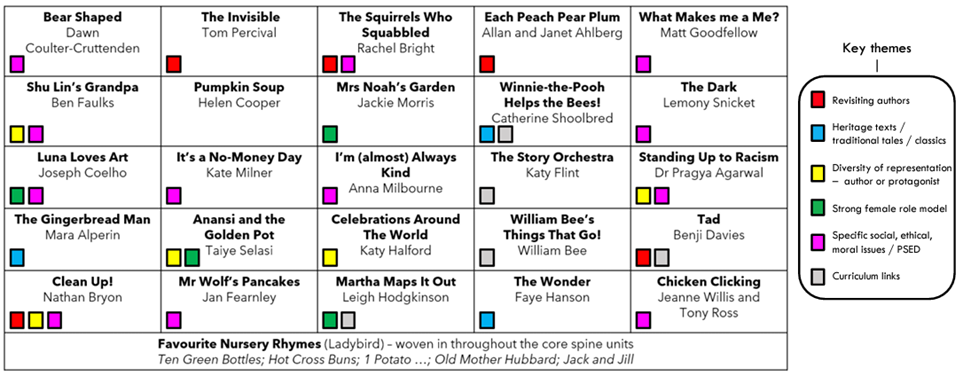
Our class literature spine:
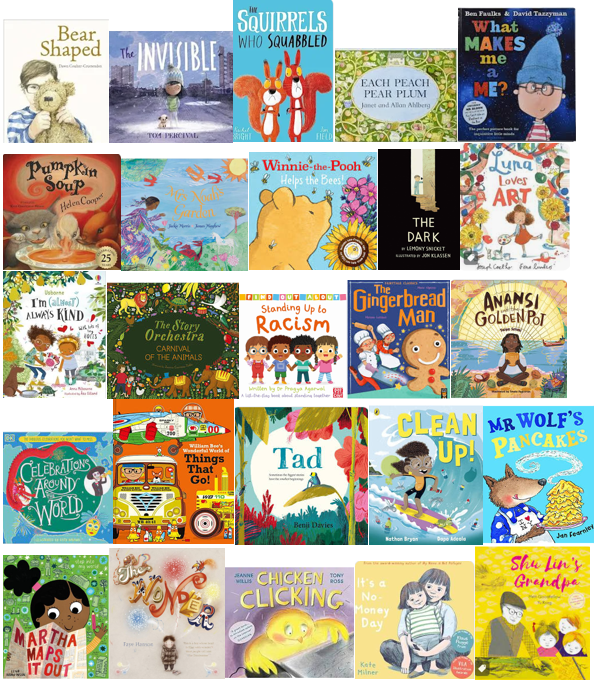
How is handwriting taught?
We use a programme called Letterjoin for our handwriting. It’s really useful for parents and carers to see how children learn letter formation using the app or desktop website. Children can also practise using a tablet at home.
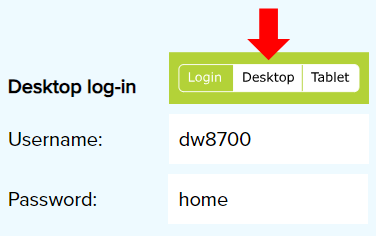
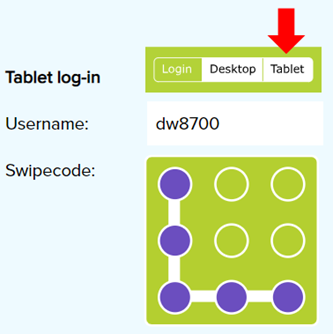
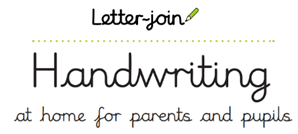
You can have a parent user manual as well. Just ask your teacher and we can give you a copy.
It’s really important for children in reception to develop a good pencil grip and form letters correctly. Any practice at home will be helpful.
How is spelling taught?
We teach spelling in reception primarily through the Read Write Inc. phonics programme.
During this time, children learn two key things in relation to spelling:
- To spell new or unfamiliar words using their phonic knowledge;
This can mean children spell words incorrectly but phonetically plausible e.g. peepl (people), majick (magic). This is ok and part of the learning process for most children! Most children tend to rely less on phonics to spell as they get older and read more.
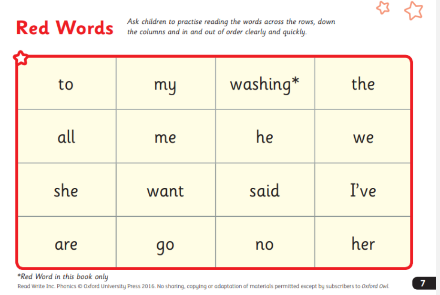
- To correctly spell high frequency words that don’t necessarily follow a simple phonic pattern e.g. the, some, of ‘off by heart'
In the Read Write Inc. books, these are the red words in the opening few pages.
 Throughout school, we want children to apply their spelling knowledge in their independent writing. However, we also don’t want worry about spelling to prevent them from writing fluently. We teach them to ‘dotty underline’ a word if they are unsure of the spelling and an adult can help them when they are free.
Throughout school, we want children to apply their spelling knowledge in their independent writing. However, we also don’t want worry about spelling to prevent them from writing fluently. We teach them to ‘dotty underline’ a word if they are unsure of the spelling and an adult can help them when they are free.
If you do any writing at home, try the same approach. If your child says, “How do you spell …?”, encourage them to say the sounds as they write, then dotty underline. Praise a good phonetic attempt and then correct them!
How is writing taught?
Writing in Reception class can be broken down into two areas:
1. Opportunities for children to write around the classroom through the ‘continuous provision’ e.g. children writing food orders in the role play café, making a thank you card or labelling plants in the garden
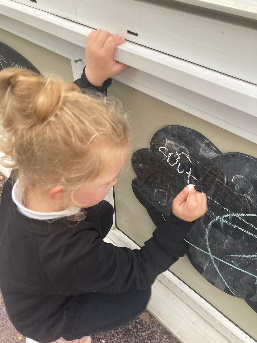
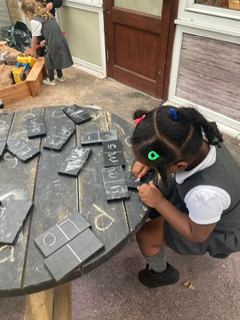
2. Writing led by the teacher, including using the Read Write Inc. Get Writing! books.
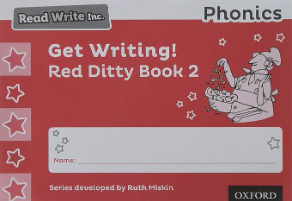
How is maths taught?
We use the White Rose EYFS mathematics scheme as the basis of our mastery-based curriculum. Although we use the scheme flexibly, the long term plan below helps to provide structure and ensure all children are ready for Year 1 by the end of the summer. Children go on to use the White Rose Curriculum for maths in Y1 through to Y6.
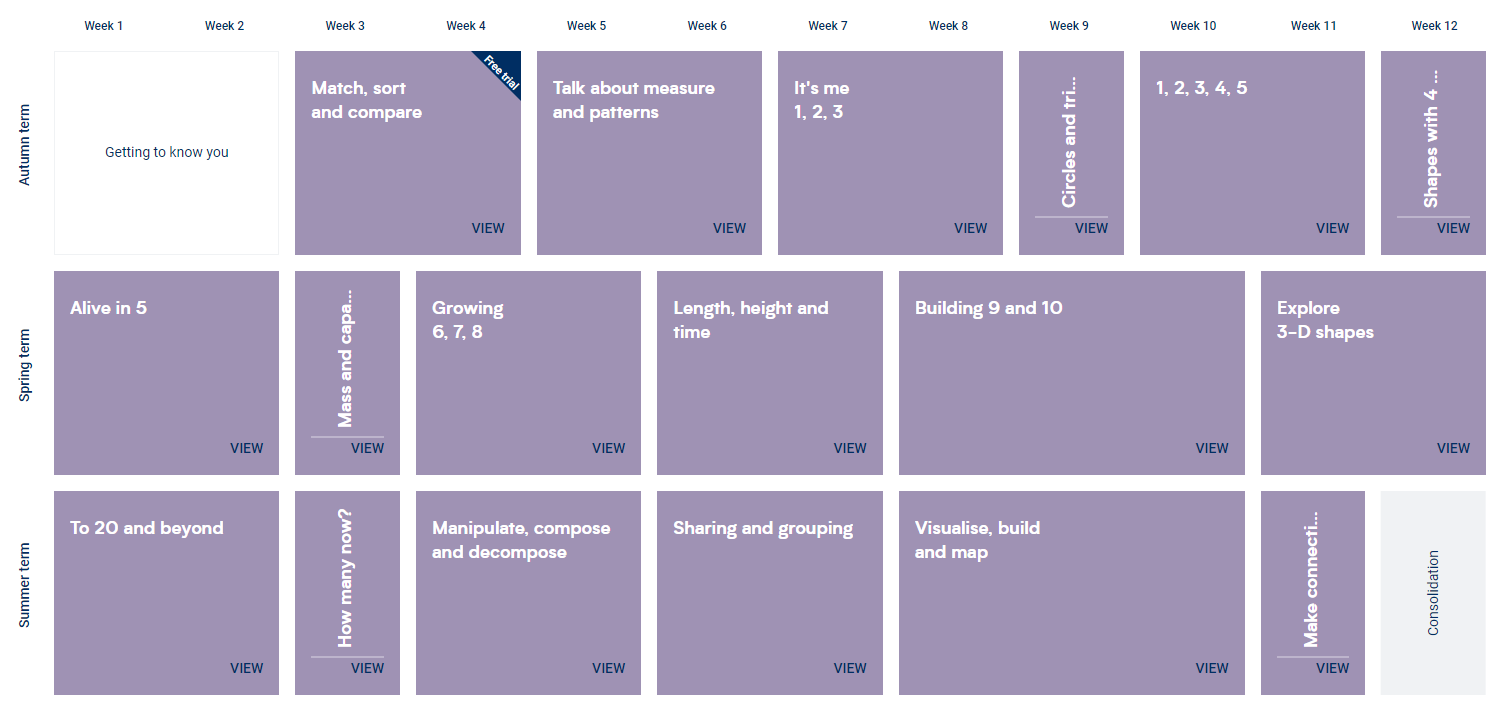
Maths carpet sessions with the whole class usually last about 15-20 minutes. During this time, children have opportunities to review what they are learning in a variety of ways, using a range of 'manipulatives' (objects), images, songs, rhymes and stories. This is to ensure they develop a deep understanding of number concepts.
There is a maths area in the classroom for children to explore and this is also used for small adult-led group work.
Some examples of the activities children may be involved in (couretesy of White Rose ©):
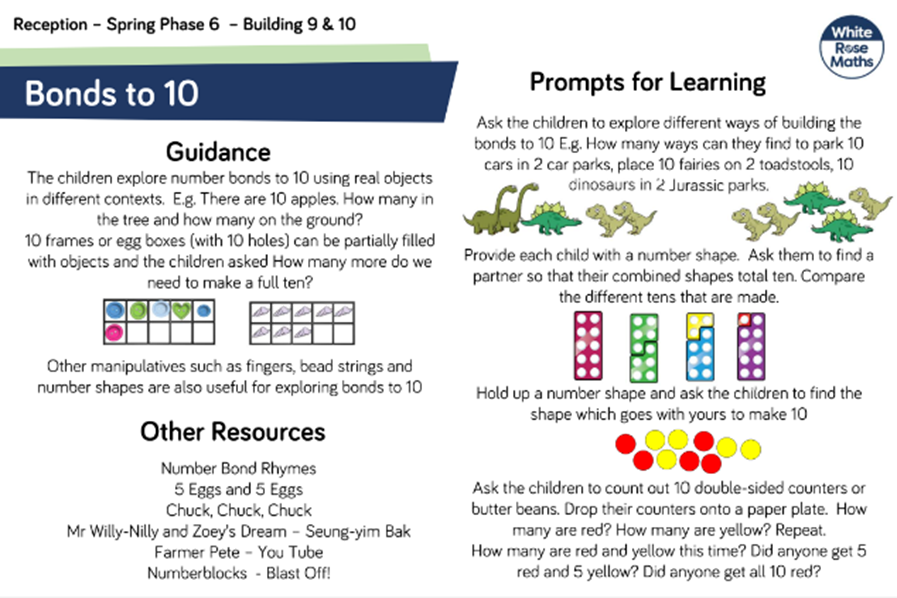
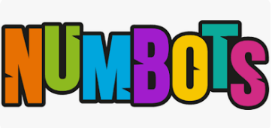
Although we don’t use this in school until Year 1, every child has a login/password. It’s an online maths journey that provides children with increasingly challenging problems. If you’d like to explore it with your child, your teacher will give you a login card.
What is Understanding the World?
Understanding the World: The Natural World
This is like the Early Years precursor to the Science curriculum.

- explore the natural world around them, making observations and drawing pictures of animals and plants (including hatching baby chicks in the spring term!)
- know some similarities and differences between the natural world around them and contrasting environments, drawing on their experiences and what has been read in class
- understand some important processes and changes in the natural world around them, including the seasons and changing states of matter.
Books that can unlock learning in this area:

Understanding the World: People and Places
This is like the Early Years precursor to the Geography curriculum.

By the end of the Reception year, children at the expected level of development will:
- describe their immediate environment using knowledge from observation, discussion, stories, non-fiction texts and maps
- know some similarities and differences between different religious and cultural communities in this country, drawing on their experiences and what has been read in class
- explain some similarities and differences between life in this country and life in other countries, drawing on knowledge from stories, non-fiction texts and when appropriate – maps.
- know some similarities and differences between things in the past and now, drawing on their experiences and what has been read in class
- understand the past through settings, characters and events encountered in books read in class and storytelling.

Understanding the World: Past and Present
This is like the Early Years precursor to the History curriculum.

By the end of the Reception year, children at the expected level of development will:
- talk about the lives of the people around them and their roles in society
- know some similarities and differences between things in the past and now, drawing on their experiences and what has been read in class
- understand the past through settings, characters and events encountered in books read in class and storytelling.

What is Expressive Arts and Design (EAD)?
Being Imaginative & Expressive
This is like the Early Years precursor to the Music, Dance and Drama curriculum.

By the end of the Reception year, children at the expected level of development will:
- Invent, adapt and recount narratives and stories with peers and their teacher.
- Sing a range of well-known nursery rhymes and songs.
- Perform songs, rhymes, poems and stories with others, and – when appropriate – try to move in time with music.
Books that can unlock learning in this area:

Creating with Materials
This is like the Early Years precursor to the Art & Design and Design Technology curriculum.

By the end of the Reception year, children at the expected level of development will:
- safely use and explore a variety of materials, tools and techniques, experimenting with colour, design, texture, form and function
- share their creations, explaining the process they have used.
Books that can unlock learning in this area:

What is the weekly timetable?
*this is our normal routine, but sometimes timings may change
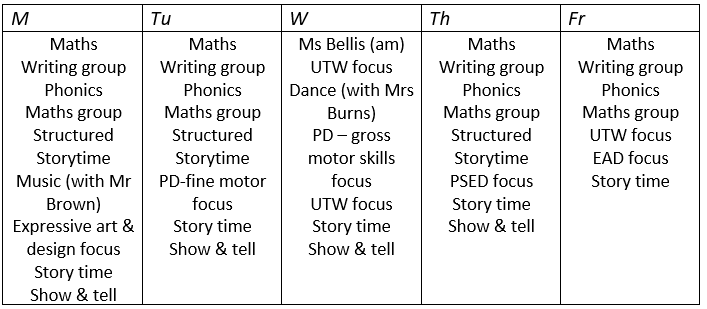
What is the school guidance on home learning?
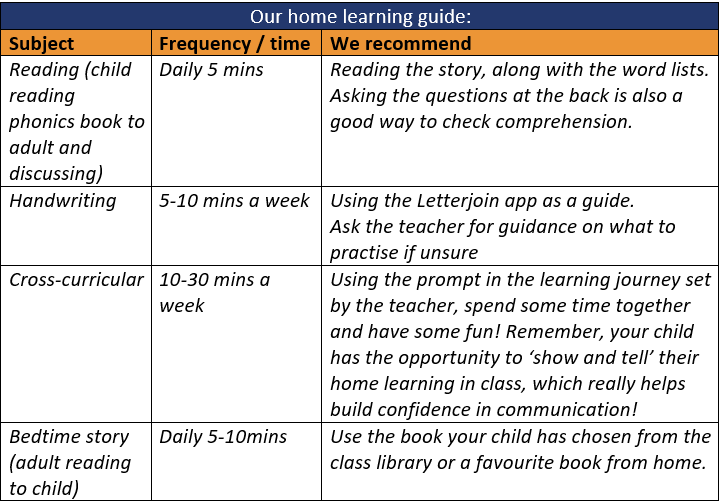
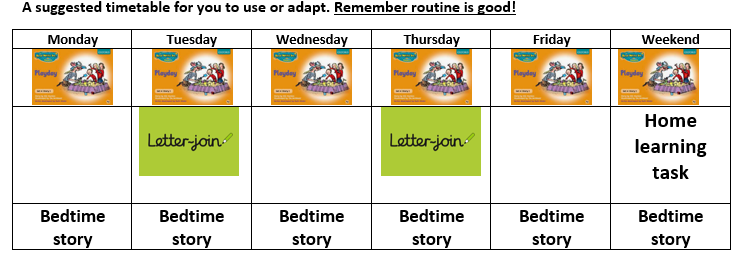
What is the plan for curriculum and extra-curricular enrichment?
Please note that this is not exhaustive. We often add in more enrichment opportunities throughout the year. These are rich experiences that we have planned already.
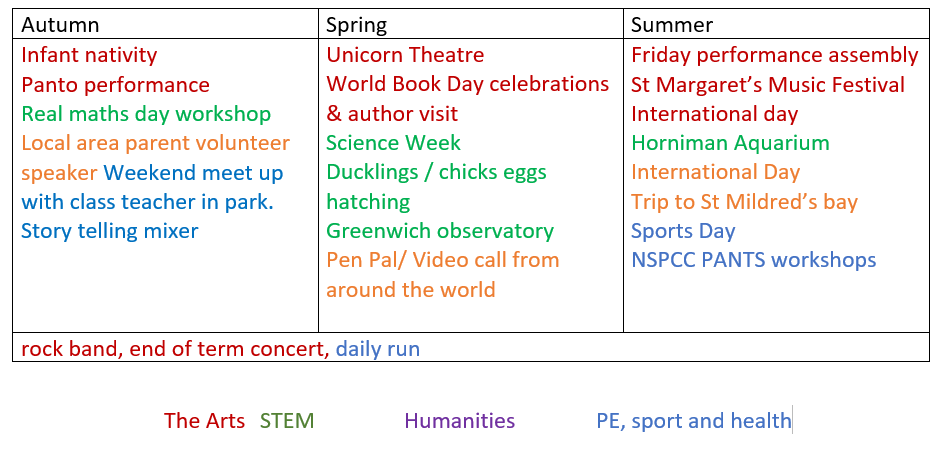
Other important information ...
- Book changing – your child gets a new Read,Write Inc book on Mondays and Thursdays (three day rotation)
- A picture book also goes home weekly that your child chooses, keep for a few days and then return to Miss Davis in order to be able to enjoy a new one
- Record reading at home in the Reading Record Book. Please sign this book and let us know how it went.
- Home learning tasks out on Friday – please bring in for Wednesday
- Only brief messages at drop-off. We want the teacher in class with the children once the bell has rung!
- If you need to speak to the teacher for a bit longer, wait until pick-up, send an email via info@stmargaretslee.lewisham.sch.uk or arrange a meeting with the teacher.
- Trainers everyday please, no hoop earrings and keep long hair tied back.
- Come and collect your child at pickup. We don’t want children running off because they think they can see their adult.
Are there any important dates we may need to plan ahead for?
Yes!
The key events that may require juggling work commitments include:
- International Day - many families join us for this afternoon celebration in mid-June
- Infant Nativity play - usually 10am towards the end of the Autumn term.
- Whole school trip to the seaside - one of the most popular events with our families. Usually towards the end of the academic year.
- Class assemblies and music assemblies - usually planned for a 9am or 3pm showing to make it easier for families to attend.
- Last day of term before Christmas, Easter and Summer holidays is a 1:30pm finish. Half terms are 3:30pm as normal.
- Sports day - usually on the Friday before May half-term. It's in the morning at Sutcliffe Park and finishes by 12:30pm
Check the website calendar for exact dates in the coming year.


